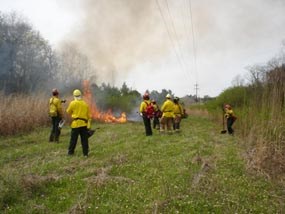|
Prescribed burning is one of the most commonly used, cost-effective methods for fuels management. A burn plan, containing a strict range of conditions that must be met, is prepared. These “prescriptions” include temperature, humidity, wind speed and direction, fuel moisture, and more. Following the prescriptions helps assure that the burn can be conducted safely and effectively. When the appropriate circumstances are present, fire personnel ignite the treatment area using devices such as drip torches, or, in large areas, helicopters. Fire personnel ensure that the fire stays within the designated burn boundaries. 
NPS Photo Prescribed burning provides many benefits to the environment. One of the most important is a return to historic fire occurrence cycles. Before intensive historic settlement, fire had a frequent and integral part in shaping the landscape. It helped to rejuvenate the forest by thinning seedlings, which kept tree density at optimal levels. This opened up the forest floor, allowing natural grasses and wildflowers to flourish. The frequency of fires also kept fuel accumulations low, and resulted in low intensity fires. These fires were not severe enough to damage and kill larger trees, thereby maintaining a healthy forest community.
Historic settlement and conversion of lands for agriculture have drastically halted, and in many areas, completely eliminated the natural cycle of fire. Prescribed fires attempt to replicate and reintroduce this cycle and restore forest communities to historical conditions. Prescribed fires are being introduced to try to mimic the natural role of fire across the landscape. Grasslands, southern pine, and oak-hickory forests are thought to have historically supported fire, although at different frequencies. On average, the Natchez Trace Parkway burns approximately 600 acres per year with prescribed fire.
Click here to find out where fire personnel are burning between October, 2010, and June, 2011. Because burn days are determined by fuel conditions and the weather, it is impossible to list more exact dates.
|
Last updated: April 14, 2015
